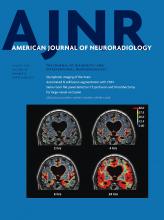Abstract
BACKGROUND AND PURPOSE: Most brain lesions are characterized by hyperintense signal on FLAIR. We sought to develop an automated deep learning–based method for segmentation of abnormalities on FLAIR and volumetric quantification on clinical brain MRIs across many pathologic entities and scanning parameters. We evaluated the performance of the algorithm compared with manual segmentation and existing automated methods.
MATERIALS AND METHODS: We adapted a U-Net convolutional neural network architecture for brain MRIs using 3D volumes. This network was retrospectively trained on 295 brain MRIs to perform automated FLAIR lesion segmentation. Performance was evaluated on 92 validation cases using Dice scores and voxelwise sensitivity and specificity, compared with radiologists' manual segmentations. The algorithm was also evaluated on measuring total lesion volume.
RESULTS: Our model demonstrated accurate FLAIR lesion segmentation performance (median Dice score, 0.79) on the validation dataset across a large range of lesion characteristics. Across 19 neurologic diseases, performance was significantly higher than existing methods (Dice, 0.56 and 0.41) and approached human performance (Dice, 0.81). There was a strong correlation between the predictions of lesion volume of the algorithm compared with true lesion volume (ρ = 0.99). Lesion segmentations were accurate across a large range of image-acquisition parameters on >30 different MR imaging scanners.
CONCLUSIONS: A 3D convolutional neural network adapted from a U-Net architecture can achieve high automated FLAIR segmentation performance on clinical brain MR imaging across a variety of underlying pathologies and image acquisition parameters. The method provides accurate volumetric lesion data that can be incorporated into assessments of disease burden or into radiologic reports.
ABBREVIATIONS:
- BIANCA
- Brain Intensity Abnormality Classification Algorithm
- CNN
- convolutional neural network
- FDR
- false discovery rate
- LST
- lesion segmentation tool
- RMdSPE
- root median squared percentage error
- RMSPE
- root mean squared percentage error
- SVID
- small-vessel ischemic disease
- © 2019 by American Journal of Neuroradiology
Indicates open access to non-subscribers at www.ajnr.org







